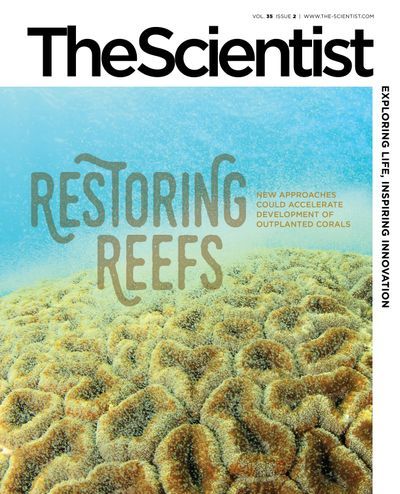Features

Restored Corals Spawn Hope for Reefs Worldwide
Hanna R. Koch, Erinn Muller, and Michael P. Crosby | Feb 1, 2021 | 10+ min read
Novel technologies establish a new paradigm for global coral reef restoration, with in situ spawning of mature, environmentally resilient corals in five years instead of decades.

Are Phages Overlooked Mediators of Health and Disease?
Catherine Offord | Feb 1, 2021 | 10+ min read
Bacteria-infecting viruses affect the composition and behavior of microbes in the mammalian gut—and perhaps influence human biology.
Contributors
Contributors
Contributors
Meet some of the people featured in the February 2021 issue of The Scientist.
Editorial
Feeling the Foundation
Feeling the Foundation
This year has started out in a fashion that is sadly similar to the way 2020 unspooled. But the steady pace of scientific discovery helps maintain our sense of hope.
Speaking of Science
Ten Minute Sabbatical
Ten Minute Sabbatical
Take a break from the bench to puzzle and peruse.
Critic at Large
Improving the Advisor/Advisee Relationship
Improving the Advisor/Advisee Relationship
Academic mentors are not necessarily natural managers. Their graduate students often bear the brunt of this shortcoming.
Notebook
Insects Might Be More Sensitive to Radiation than Thought
Insects Might Be More Sensitive to Radiation than Thought
A study of bumble bees exposed to levels of radiation equivalent to those existing in Chernobyl hotspots shows that the insects’ reproduction takes a hit.
Specialized Leaves Keep This Plant’s Fruit Warm
Specialized Leaves Keep This Plant’s Fruit Warm
A volunteer nature guide teamed up with researchers to discover a unique reproductive role for one vine’s leaves.
The Literature
Petunia’s Waxy Cuticle Regulates the Plant’s Sweet Smell
Petunia’s Waxy Cuticle Regulates the Plant’s Sweet Smell
The thicker the flower petals’ cuticle, the more fragrance compounds the plant releases, according to a recent study.
Retrons Help Bacteria Defend Themselves from Phages: Study
Retrons Help Bacteria Defend Themselves from Phages: Study
The mysterious DNA sequences appear to help bacterial cells spot when they’ve been infected with viruses—and prompt those cells to self-destruct.
Invertebrate Density Influences Plant Flowering Times, Abundance
Invertebrate Density Influences Plant Flowering Times, Abundance
An experimental study explores how plant communities may be affected by future declines in invertebrate populations.
Scientist to Watch
Siobhán Brady Uses Big Data to Investigate Plant Development
Siobhán Brady Uses Big Data to Investigate Plant Development
The University of California, Davis, professor is a pioneer in teasing apart the changes in gene expression that drive root development.
Bio Business
Biopharma Looks to the Netherlands as European Hub
Biopharma Looks to the Netherlands as European Hub
The recent move of the European Medicines Agency from London to Amsterdam is a reflection of the city’s vibrant life sciences and health sector and supporting industries.
Reading Frames
Opinion: Europe Is Sinking Biotech—Again
Opinion: Europe Is Sinking Biotech—Again
Scientifically groundless regulations could undercut the potential of gene-edited crops, much as they have with GMOs.
Foundations
Viral Discoveries, 1929
Viral Discoveries, 1929
The “mother of plant virology and serology,” Helen Purdy Beale, developed techniques to understand the nature of viruses that went unappreciated for decades.
Infographics
Infographic: A Plant Cell’s Cuticle Helps Regulate Toxic Chemical Accumulation
Infographic: A Plant Cell’s Cuticle Helps Regulate Toxic Chemical Accumulation
Researchers found that thinning petunia cells’ cuticles caused them to slow production of volatile organic compounds.
Infographic: Trans-kingdom Interactions in the Gut
Infographic: Trans-kingdom Interactions in the Gut
Phages interact with bacteria and eukaryotic cells in ways that researchers suspect influence mammalian health.
Infographic: How to Accelerate the Growth of Restored Corals
Infographic: How to Accelerate the Growth of Restored Corals
Our novel technique involves planting several small fragments of slow-growing corals onto dead coral heads. The fragments eventually fuse, forming a large colony in a fraction of the time that it takes wild corals to build reefs.
















